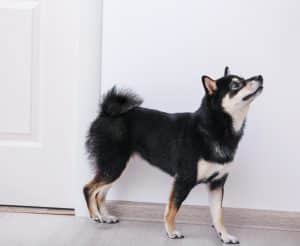
When your dog waits by the door, they’re giving you a clear potty signal, be ready to reward them for asking politely!
Potty training is one of the most important foundations of living harmoniously with your dog. Whether you’re raising a brand-new puppy or adopting an adult rescue, accidents in the house can be frustrating and discouraging. Many pet parents feel like they’re doing something wrong, or worse, that their dog is “stubborn.”
The truth is that potty training problems are common and almost always solvable with the right plan, patience, and consistency. In this guide, we’ll explore:
- The most common potty-training challenges in puppies and adult dogs.
- Why these problems happen in the first place.
- Step-by-step strategies to fix potty training issues.
- When to seek professional help.
By the end, you’ll feel confident tackling accidents and building a stress-free routine that works for both you and your dog.
Why Potty Training Can Be Challenging
Puppies: Learning From Scratch
For puppies, everything is new. Their bladders and bowels are still developing, their schedules are unpredictable, and they’re still learning how to communicate. Potty training takes time because puppies simply cannot hold it for long. As a rule of thumb, a puppy can only hold their bladder for about one hour per month of age (e.g., a 3-month-old puppy = 3 hours). This rule can vary depending on the size of your puppy, congenital defects, and learning history. This should be used as a guideline.
Adult Dogs: New Homes, New Routines
Rescue dogs or adult dogs from breeders may struggle with potty training because:
- They never learned reliable habits in their previous home.
- They were kept in environments where accidents were unavoidable.
- They’re adjusting to a brand-new space, which feels like starting over.
Common Misconceptions
Some pet parents think their dog is being spiteful, lazy, or “getting back at them.” In reality, potty training problems are rarely about disobedience, they’re about unmet needs, incomplete training, or medical issues.
The Most Common Potty Training Problems
1. Frequent Accidents Indoors
This is the most common issue, especially with puppies. If your dog consistently goes indoors, it usually means:
- They don’t understand where they should go.
- They aren’t taken out often enough.
- They don’t have a clear schedule.
2. Submissive or Excitement Urination
Some dogs pee when greeting new people, when scolded, or when overly excited. This isn’t a house training problem, it’s an emotional response.
3. Marking Behavior
Dogs, especially males, may urinate small amounts to mark territory indoors. This is different from a full accident.
4. Regression After Progress
Many puppies seem “potty trained” for a few weeks, only to start having accidents again. Regression is normal and often linked to changes in routine, teething, or simply pushing boundaries.
5. Medical Issues
Sometimes accidents aren’t training-related at all. Urinary tract infections (UTIs), bladder stones, gastrointestinal upset, and incontinence can cause dogs to go indoors. Always rule out medical causes with a veterinarian if accidents suddenly increase.
Solutions: How to Fix Potty Training Problems
1. Set a Consistent Schedule
Dogs thrive on routine. Take your dog outside:
- First thing in the morning.
- After every meal.
- After naps.
- After playtime
- Before bedtime.
- Every 2–3 hours for puppies, and more frequently if needed.
Tip: Keep a potty log. Write down the times your dog eats, drinks, sleeps, and eliminates. Patterns will emerge quickly.
2. Supervise Closely Indoors
Until your dog is reliable, supervision is key. Use baby gates, playpens, or leashes indoors so you can interrupt before an accident happens.
3. Use Positive Reinforcement
When your dog goes in the right spot, celebrate! Use treats, praise, and play immediately after they finish. Timing matters, reward within 3 seconds.
4. Don’t Punish Accidents
Yelling or rubbing a dog’s nose in a mess doesn’t teach them where to go, it teaches them to fear going in front of you. Instead, calmly clean up accidents with an enzyme cleaner to remove odors.
5. Crate Training
Crates are an excellent potty training tool because most dogs avoid soiling where they sleep. Choose the right size, big enough to stand and turn around, but not so large they can use one corner as a bathroom. If you need help, here’s our guide to crate training.
6. Address Submissive and Excitement Urination
- Keep greetings calm and low-key.
- Build confidence through positive reinforcement training.
- Avoid scolding, this only makes the problem worse.
7. Handle Marking Behavior
- Neutering often reduces marking.
- Supervise and interrupt marking indoors.
- Reward outdoor elimination in appropriate spots.
8. Troubleshoot Regression
- Revisit the basics: schedule, supervision, rewards.
- Reduce freedom indoors temporarily.
- Be consistent, setbacks are normal and usually temporary.
Potty Training Do’s and Don’ts
Do:
- Be patient. Potty training takes weeks to months.
- Stick to a predictable schedule.
- Praise generously for outdoor successes.
- Clean accidents with enzyme-based cleaners.
Don’t:
- Punish or scold for accidents.
- Assume your dog “knows better.”
- Give too much freedom too soon.
Tools That Can Help
- Enzyme cleaners (e.g., Nature’s Miracle) to eliminate odor.
- Training pads as a short-term option (best for very young puppies or small breeds).
- Crates and playpens to create safe spaces and manage freedom.
When to Call a Professional
If you’ve been consistent for several weeks and still struggle, it may be time to consult a professional dog trainer who uses positive reinforcement methods. A trainer can help identify patterns, adjust your strategy, and rule out behavioral concerns.
Additionally, always consult a veterinarian if:
- Your dog was previously trained but suddenly has accidents.
- There is blood in urine or stool.
- Accidents are accompanied by lethargy, vomiting, or weight loss.
Potty training problems can feel overwhelming, but remember: your dog isn’t being stubborn or disobedient. They’re learning, adjusting, or communicating a need. With patience, supervision, and positive reinforcement, every dog can become reliably potty trained.
If you’re struggling, you don’t have to go through it alone. Professional help is available, and sometimes just one session with a trainer makes all the difference.
